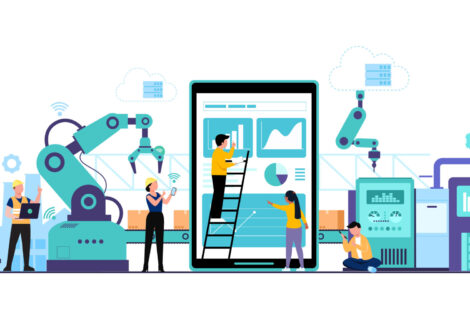Top 2023 Digital Trends Centre on Next-Gen, Advancing and Immersive Technologies
Businesses are taking proactive measures to maximise opportunities, appeal to digital-savvy consumers and combat privacy, safety and cybersecurity threats. In the business-to-business (B2B) market, companies are exploring new technologies, investing in education and hiring experienced professionals.
So let’s dive in and discover the exciting digital trends shaping our futures.
Building their digital futures
B2B companies actively shape their digital futures by leveraging next-generation, advancing and immersive technologies. These companies embrace the latest technology trends to stay ahead in the digital landscape. They understand the importance of adopting new technologies to remain competitive and meet changing customer needs.
By embracing artificial intelligence (AI), machine learning and augmented reality (AR) advancements, B2B companies can enhance their products and services, streamline operations and improve customer experiences. These digital futures are centred around innovation and creativity, empowering B2B companies to drive growth and stay relevant in today’s fast-paced business environment.
With a focus on technology-driven solutions, B2B companies are positioning themselves as leaders in their respective industries, ensuring their place in the digital economy.
1. Applied AI in businesses
To understand how businesses use applied AI, let’s imagine a world where machines learn from data and make intelligent decisions to streamline processes and enhance productivity.
Applied AI refers to using artificial intelligence (AI) technology in real-world business scenarios. It involves using algorithms and machine learning techniques to analyse data, identify patterns and make predictions.
By leveraging applied AI, businesses can automate repetitive tasks, optimise operations and gain valuable insights from large datasets. However, as with any technology, businesses must be aware and cautious of cybersecurity threats. As applied AI becomes more prevalent, the risk of data breaches and unauthorised access increases.
Businesses must implement robust cybersecurity measures to protect sensitive information and ensure their AI systems’ integrity.
2. Next-generation software development
Are you curious about the future of software development and how it’s evolving to meet the demands of our rapidly changing world? Next-generation software development is at the forefront of digital trends, incorporating next-gen, advancing and immersive technologies.
It focuses on creating innovative solutions that push the boundaries of what is possible in the digital realm. Its evolution is driven by the need to stay competitive in a fast-paced, technology-driven landscape.
To give you a better understanding, let’s take a look at the table below:
| Next-Gen Software Development Features | Advantages | Examples |
| Artificial Intelligence (AI) Integration | Enhances efficiency and accuracy in decision-making processes | AI-powered chatbots, predictive analytics |
| Cloud Computing Integration | Enables scalability and accessibility of software applications | Cloud-based storage, software-as-a-service (SaaS) |
| Virtual Reality (VR) Integration | Offers immersive user experiences and simulations | VR gaming, virtual training environments |
| Internet of Things (IoT) Integration | Connects devices to gather and exchange data, enabling automation | Smart homes, wearable devices |
| Blockchain Integration | Provides secure and transparent data transactions | Cryptocurrencies, supply chain management |
Next-generation software development embraces these technologies to create cutting-edge solutions that address business and consumers’ evolving needs. It opens up exciting possibilities for innovation and growth in various industries. Software development will play a vital role in shaping the future’s digital landscape as technology advances.
Next-gen development
Here are three key developments to keep an eye on:
- Artificial Intelligence (AI) Integration: AI is revolutionising software development by enabling machines to learn, adapt and make intelligent decisions. Developers incorporate AI algorithms into their applications to enhance functionality and provide personalised user experiences.
- Augmented Reality (AR) and Virtual Reality (VR): These immersive technologies transform how we interact with software. From gaming and entertainment to training and education, AR and VR are creating new possibilities for user engagement and enhancing the overall user experience.
- Internet of Things (IoT) Integration: The IoT connects devices and systems like never before, enabling software developers to create innovative applications that leverage data from interconnected devices. This integration drives the development of smart homes, cities and industries, with software playing a crucial role in managing and analysing the vast amount of data generated.
3. Advanced connectivity
Discover the exciting world of advanced connectivity and how it’s revolutionising how we connect, communicate and interact with the digital landscape.
In technology trends, advanced connectivity is a crucial component that enables seamless and efficient communication between devices, networks and users. It encompasses a wide range of technologies, such as 5G, the Internet of Things (IoT), and edge computing, all aimed at enhancing connectivity and enabling real-time data exchange. Advanced connectivity facilitates faster and more reliable internet connections and paves the way to adopt immersive technologies like AR and VR.
These immersive technologies offer unique and engaging experiences by integrating digital content into the physical world, transforming various industries such as gaming, entertainment, healthcare and education. With advanced connectivity at the forefront, the possibilities for immersive technologies are boundless, revolutionising how we interact with the digital sphere.
The changing face of connectivity
As the digital landscape continues to evolve, advanced connectivity plays a crucial role in connecting devices, systems and people like never before. The increasing demand for seamless and efficient communication in professional settings drives this development.
Advanced connectivity encompasses technologies such as 5G, the Internet of Things (IoT), and edge computing, which enable faster and more reliable connections. These advancements pave the way for innovations in various industries, including healthcare, transportation and manufacturing.
With the rapid evolution of advanced connectivity, we can expect to see even more interconnected and intelligent systems, fostering a world where information flows effortlessly and enhances our daily lives.
4. Immersive-reality technologies
From virtual reality (VR) to augmented reality (AR) and mixed reality (MR), immersive technologies create realistic and interactive experiences that blur the line between the physical and digital realms. These next-gen technologies offer endless possibilities across various industries. In healthcare, immersive technologies can enhance medical training and improve patient outcomes.
In education, they can create immersive learning experiences that engage students on a whole new level. In entertainment, immersive technologies can transport audiences into virtual worlds and elevate the gaming experience.
As these advancing technologies continue to evolve, they will undoubtedly shape the future of how we work, learn and play. Get ready to be immersed in a world where the boundaries of reality are pushed to new heights.
Embracing evolution
Immersive reality technologies continuously evolve and blur the boundaries between the physical and digital realms. These advancing technologies, such as VR and augmented AR, captivate individuals and industries. They transport users to virtual environments or enhance the real world with digital elements, creating immersive experiences that engage our senses.
These technologies are becoming more accessible and realistic with the rapid development of hardware and software. They are revolutionising various sectors, from gaming and education to healthcare and design, by offering unique and interactive experiences that push the boundaries of what is possible. As technology trends continue to unfold, the potential for immersive technologies to shape the future is vast. They promise a world where the digital and physical seamlessly intertwine.
5. Mobile commerce
Explore how mobile commerce is evolving and transforming how you shop and interact with businesses, offering convenience, personalised experiences and seamless transactions at your fingertips.
With advancing technologies, mobile commerce has become vital to the digital landscape, allowing consumers to purchase and engage with brands anytime, anywhere. The rise of mobile businesses is driven by the increasing use of smartphones and the availability of high-speed internet connections.
Mobile commerce offers numerous benefits, including easy access to product information, personalised recommendations, and secure payment options.
To illustrate the impact of mobile commerce, consider the following table:
| Advantages of Mobile Commerce | Challenges of Mobile Commerce |
| Convenience and accessibility | Security and privacy concerns |
| Personalised shopping experiences | Limited screen size for product display |
| Seamless and quick transactions | Network connectivity issues |
| Integration with emerging technologies | Compatibility issues with different devices |
As technology trends evolve, mobile commerce is expected to enhance the shopping experience further, providing even more personalised and immersive business interactions.
Frequently Asked Questions
What are some strategies that B2B companies are using to build their digital futures?
B2B companies are building their digital futures by adopting strategies such as investing in advanced technologies, hiring experienced professionals, conducting regular audits and educating employees.
How does applied AI benefit businesses, and what are some examples of its use in different industries?
Applied AI benefits businesses by automating processes, improving decision-making and enhancing customer experiences. In healthcare, it helps with diagnosing diseases and providing personalised treatment. In finance, it aids in fraud detection and risk assessment. In manufacturing, it optimises operations and predictive maintenance.
Can you explain the concept of next-generation software development and how it differs from traditional software development?
Next-generation software development involves using advanced technologies and methodologies to create innovative and cutting-edge software solutions. It differs from traditional software development as it leverages emerging trends like AI, cloud computing and immersive technologies to deliver more efficient and impactful products.
What are some recent advancements and trends in advanced connectivity?
Recent advancements in advanced connectivity include the development of 5G networks, Internet of Things (IoT) devices and edge computing. These technologies enable faster and more reliable connections, enhanced device communication and improved data processing capabilities.
How are immersive-reality technologies being developed, and what are some potential applications in various fields?
Immersive technologies like VR and AR are being developed to create realistic and interactive experiences. They have potential applications in gaming, education, healthcare, and architecture, enhancing training, visualisation, and user engagement.
Digital growth in 2023
The high-tech industry is experiencing significant growth and advancements in various fields. These include applied AI, next-generation software development, advanced connectivity, and immersive-reality technologies. These trends are shaping the digital future for B2B companies and driving innovation.
However, the industry also faces challenges, such as a shortage of qualified talent and cybersecurity threats. Companies are investing in cybersecurity education, adopting new technologies, and hiring experienced professionals to address these concerns.
As technology continues to advance, it is crucial for businesses to stay updated and adapt to the changing digital landscape.
To find out more, contact AIT Systems today.





